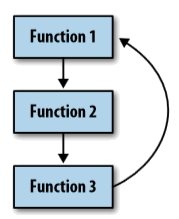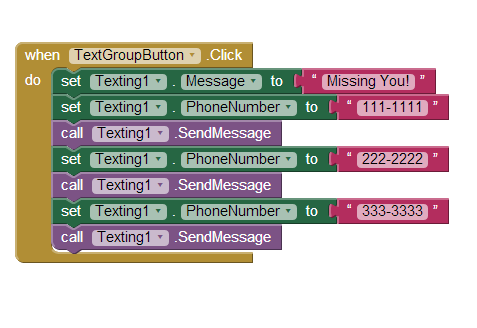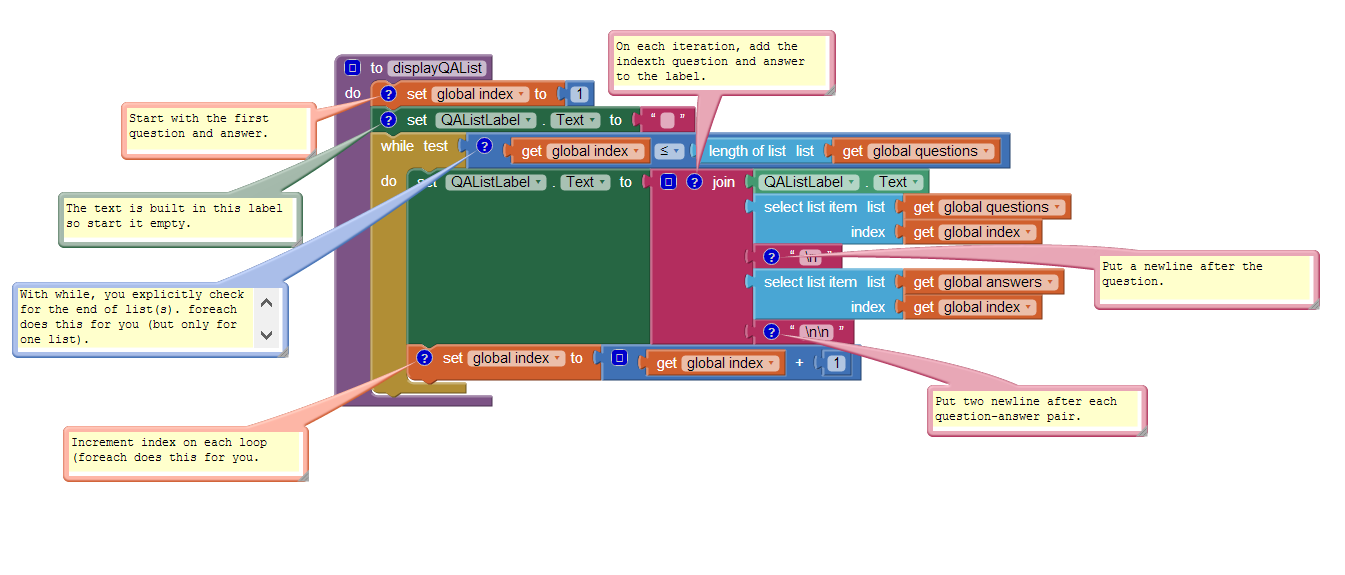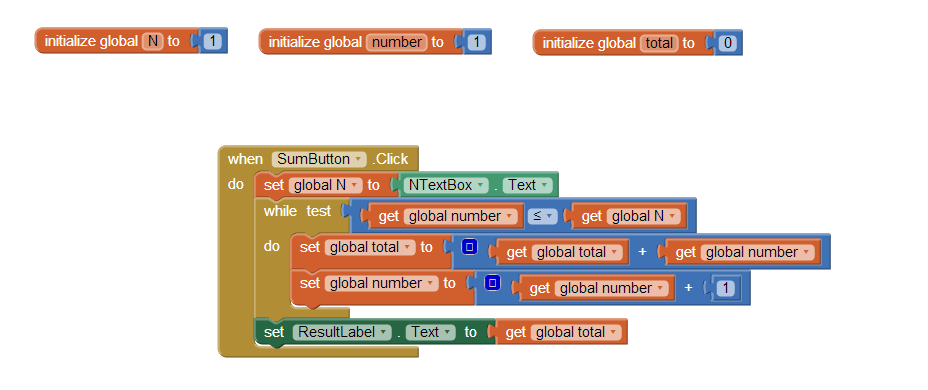One thing computers are good at is Iteration operations-like little children, they never tire of repetition. They are also very fast and can do things like process your entire list of Facebook friends in a microsecond.
In this chapter, you'll learn how to program repetition with just a few blocks instead of copying and pasting the same blocks over and over. You'll learn how to do things like send an SMS text to every phone number in a list and sort list items. You'll also learn that repeat blocks can significantly simplify an app.

In previous chapters, you learned that you define an app's behavior with a set of event handlers: events and the functions that should be executed in response. You also learned that the response to an event is often not a linear sequence of functions and can contain blocks that are performed only under certain conditions.
Repeat blocks are the other way in which an app behaves nonlinearly. Just as if and ifelse blocks allow a program to branch, repeat blocks allow a program to loop; that is, to perform some set of functions and then jump back up in the code and do it again, as illustrated in Figure 20-1. When an app executes, a program counter working beneath the hood of the app keeps track of the next operation to be performed. So far, you've examined apps in which the program counter starts at the top of an event handler and (conditionally) performs operations top to bottom. With repeat blocks, the program counter loops back up in the blocks, continuously Iteration functions.

Figure 20-1. Repeat blocks cause a program to loop
In App Inventor, there are two types of repeat blocks: foreach and while.foreach is used to specify functions that should be performed on each item of a list. So, if you have a list of phone numbers, you can specify that a text should be sent to each number in the list
The while block is more general than the foreach. With it, you can program blocks that continually repeat until some arbitrary condition changes. while blocks can be used to compute mathematical formulas such as adding the first n numbers or computing the factorial of n. You can also use while when you need to process two lists simultaneously; foreach processes only a single list at a time.
In Chapter 18, we discussed a Random Call app. Randomly calling one friend might work out sometimes, but if you have friends like mine, they don't always answer. A different strategy would be to send a "Missing you" text to all of your friends and see who responds first (or more charmingly!).
With such an app, clicking a button sends a text to more than one friend. One way to implement this would be to simply copy the blocks for texting a single number, and then copy and paste them for each friend you want to text, as shown in Figure 20-2.

Figure 20-2. Copying and pasting the blocks for each phone number to be texted
This "brute force" copy-paste method is fine if you have just a few blocks to repeat. But data lists, such as the list of your friends, tend to change. You won't want to have to modify your app with the copy-paste method each time you add or remove a phone number from your list.
The foreach block provides a better solution. You define a phoneNumbers list variable with all the numbers and then wrap a foreach block around a single copy of the blocks you want to perform. Figure 20-3 shows the foreach solution for texting a group.

Figure 20-3. Using the foreach block to perform the same blocks for each item in the list
This code can be read as:
For each item (phone number) in the list phoneNumbers, set the Texting object's phone number to the item and send out the text message.
When you drag out a foreach block, you must specify the list to process by plugging a reference into the "in list" parameter slot. In this case, the get global phoneNumbers block was dragged out the phoneNumbers initialization block and plugged in to provide the list of phone numbers to text.
At the top of the foreach block, there is also a placeholder variable that comes with the foreach. By default, this placeholder is named "item." You can leave it that way or rename it. This variable represents the current item being processed in the list.
The blocks within the foreach are repeated for each item in the list, with the placeholder variable (in this example, item) always holding the item currently being processed. If a list has three items, the inner blocks will be executed three times. The inner blocks are said to be subordinate to, or within, the foreach block. We say that the program counter "loops" back up when it reaches the bottom block within the foreach.
Let's examine the mechanics of the foreach blocks in detail, because understanding loops is fundamental to programming. When the TextGroupButton is clicked and the event handler invoked, the first operation executed is the set Texting1.Message to block, which sets the message to "Missing you." This block is only executed once.
Theforeach block then begins. Before the inner blocks of a foreach are executed, the placeholder variable item is set to the first number in the phoneNumbers list (111–1111). This happens automatically; the foreach relieves you of having to manually call select list item. After the first item is selected into the variable item, the blocks within the foreach are executed for the first time. The Texting1.PhoneNumber property is set to the value of item (111–1111), and the message is sent.
After reaching the last block within a foreach (the Texting.SendMessage block), the app "loops" back up to the top of the foreach and automatically puts the next item in the list (222–2222) into the variable item. The two operations within the foreach are then repeated, sending the "Missing you" text to 222–2222. The app then loops back up again and sets item to the last item in the list (333–3333). The operations are repeated a third time, sending the third text.
Because the final item in the list-in this case, the third has been processed, the foreach looping stops at this point. We say that control "pops" out of the loop, which means that the program counter moves on to deal with the blocks below the foreach. In this example, there are no blocks below it, so the event handler ends.
To the end user, the foreach solution just described behaves exactly the same as the "brute force" method of copying and then pasting the texting blocks. From a programmer's perspective, however, the foreach solution is more maintainable and can be used even if the data (the phone list) is entered dynamically.
Maintainable software is software that can be changed easily without introducing bugs. With the foreach solution, you can change the list of friends who are sent texts by modifying only the list variable-you don't need to change the logic of your program (the event handler) at all. Contrast this with the brute force method, which requires you to add new blocks in the event handler when a new friend is added. Anytime you modify a program's logic, you risk introducing bugs.
Even more important, the foreach solution would work even if the phone list was dynamic-that is, one in which the end user, not just the programmer, could add numbers to the list. Unlike our sample, which has three particular phone numbers listed in the code, most apps work with dynamic data that comes from the end user or some other source. If you redesigned this app so that the end user could enter the phone numbers, you would have to use a foreach solution, because when you write the program, you don't know what numbers to put in the brute force solution.
When you want to display the items of a list on the phone, you can plug the list into the Text property of a Label, as shown in Figure 20-4.

Figure 20-4. The simple way to display a list is to plug it directly into a label
When you plug a list directly into a Text property of a Label, the list items are displayed in the label as a single row of text separated by spaces and contained in parentheses: (111–1111 222–2222 333–3333)
The numbers may or may not span more than one line, depending on how many there are. The user can see the data and perhaps comprehend that it's a list of phone numbers, but it's not very elegant. List items are more commonly displayed on separate lines or with commas separating them.
To display a list properly, you need blocks that transform each list item into a single text value with the formatting you want. Text objects generally consist of letters, digits, and punctuation marks. But text can also store special control characters, which don't map to a character you can see. A tab, for instance, is denoted by \t. (To learn more about control characters, check out the Unicode standard for text representation at ***http://www.unicode.org/standard/standard.html.)
In our phone number list, we want a newline character, which is denoted by \n. When \n appears in a text block, it means "go down to the next line before you display the next thing." So the text object "111–1111\n222–2222\n333–3333" would appear as:
111–1111
222–2222
333–3333
To build such a text object, we use a foreach block and "process" each item by adding it and a newline character to the PhoneNumberLabel.Textproperty, as shown in Figure 20-5.

Figure 20-5. Using the foreach block to process the list and put a newline character before each item
Let's trace the blocks to see how they work. As discussed in Chapter 15, tracing shows how each variable or property changes as the blocks are executed. With a foreach, we consider the values after each iteration that is, each time the program goes through the foreach loop.
Before the foreach, the PhoneNumbersLabel, is initialized to the empty text. When the foreach begins, the app automatically places the first item of the list (111–1111) into the placeholder variable number. The blocks in the foreach then make text with PhoneNumbersLabel.Text (the empty text), \n, and number, and set the result into PhoneNumbersLabel.Text. Thus, after the first iteration of the foreach, the pertinent variables store the values shown in Table 20-1.
Table 20-1. The values of the variables after the first iteration of foreach

Since the bottom of the foreach has been reached, control loops back up and the next item of the list (222–2222) is put into the variable number. When the inner blocks are repeated, make text concatenates the value of PhoneNumbersLabel.Text (\n111–1111) with \n, and then with number, which is now 222–2222. After this second iteration, the variables store the values shown in Table 20-2.
Table 20-2. The variable values after the second iteration of foreach

The third item of the list is then placed in number, and the inner block is repeated a third time. The final value of the variables, after this last iteration, is shown in Table 20-3.
Table 20-3. The variable values after the final iteration

111–1111
222–2222
333–3333
The while block is a bit more complicated to use than foreach. The advantage of the while block lies in its generality: foreach repeats over a list, but while can repeat while any arbitrary condition is true. As a trivial example, suppose you wanted to text every other person in your phone list. You couldn't do it with foreach, but with while, you could just increment the index by two instead of one each time.
As you learned in Chapter 18, a condition tests something and returns a value of either true or false. while-do blocks include a conditional test, just like if blocks. If the test of a while evaluates to true, the app executes the inner blocks, and then loops back up and rechecks the test. As long as the test evaluates to true, the inner blocks are repeated. When the test evaluates to false, the app "pops" out of the loop (like we saw with the foreach block) and continues with the blocks below the while.
A more instructive example of while and its generality involves situations in which you need to process two lists in a synchronous fashion. For example, in the MakeQuiz app (Chapter 10), you keep separate lists of the quiz questions and answers, along with an index variable to keep track of the current question number. To display each question-answer pair together, you need to iterate through the two lists in a synchronous fashion, grabbing the indexth item of each. foreach only allows for traversing a single list, but with a while loop, you can use the index to grab an item from each list. Figure 20-6 illustrates using a while block to display the question-answer pairs on separate lines.

Figure 20-6. Using a while loop to display the question-answer pairs on separate lines
Because a while is used instead of a foreach, the blocks explicitly initialize the index, check for the end of the list, select the items in each loop, and increment the index.
Here's another example of while that repeats operations but has nothing to do with a list. What do you think the blocks in Figure 20-7 do, at a high level? One way to figure this out is to trace each block (see Chapter 15 for more on tracing), tracking the value of each variable as you go.

Figure 20-7. Can you figure out what these blocks are doing?
The blocks within the while loop will be repeated while the variable number is less than or equal to the variable N. For this app, N is set to a number that the end user enters in a text box (NTextBox). Say the user entered a 3. The variables of the app would look like Table 20-4 when the while block is reached.
Table 20-4. This is how the variables look when the while block is reached

The while block first asks: is number less than or equal to (≤) N? The first time this question is asked, the test is true, so execution proceeds within the while block. total is set to itself (0) plus number (1), and number is incremented. After the first iteration of the blocks within the while, the variable values are as listed in Table 20-5.
Table 20-5. The variable values after the first iteration of the blocks within the while block

On second iteration, the test "number≤N" is still true (2≤3), so the inner blocks are executed again. total is set to itself (1) plus number (2). number is incremented. When this second iteration completes, the variables are as listed in Table 20-6.
Table 20-6. The variable values after the second iteration

The app loops back up again and tests the condition. Once again, it is true (3≤3), so the blocks are executed a third time. Now total is set to itself (3) plus number (3), so it becomes 6. number is incremented to 4, as shown in Table 20-7.
Table 20-7. The values after the third iteration

After this third iteration, control loops back one more time. Now the test "number≤N", or 4≤3, evaluates to false. Thus, the inner blocks of the while are not executed again, and the event handler completes.
So what did these blocks do? They performed one of the most fundamental mathematical operations: counting numbers. Whatever number the user enters, the app will report the sum of the numbers 1..N, where N is the number entered. In this example, we assumed the user had entered 3, so the app came up with a total of 6. If the user had entered 4, the app would have calculated 10.
Computers are good at Iteration the same function over and over. Think of all the bank accounts that are processed to accrue interest, all the grades processed to compute students' grade point averages, and countless other everyday examples where computers use repetition to perform a task.
App Inventor provides two blocks for Iteration operations. The foreach block applies a set of functions to each element of a list. By using it, you can design processing code that works on an abstract list instead of concrete data. Such code is more maintainable, and it's required if the data is dynamic.
Compared to foreach, while is more general: you can use it to process a list, but you can also use it to synchronously process two lists or compute a formula. With while, the inner blocks are performed continuously while a certain condition is true. After the blocks within the while are executed, control loops back up and the test condition is tried again. Only when the test evaluates to false does the while block complete.